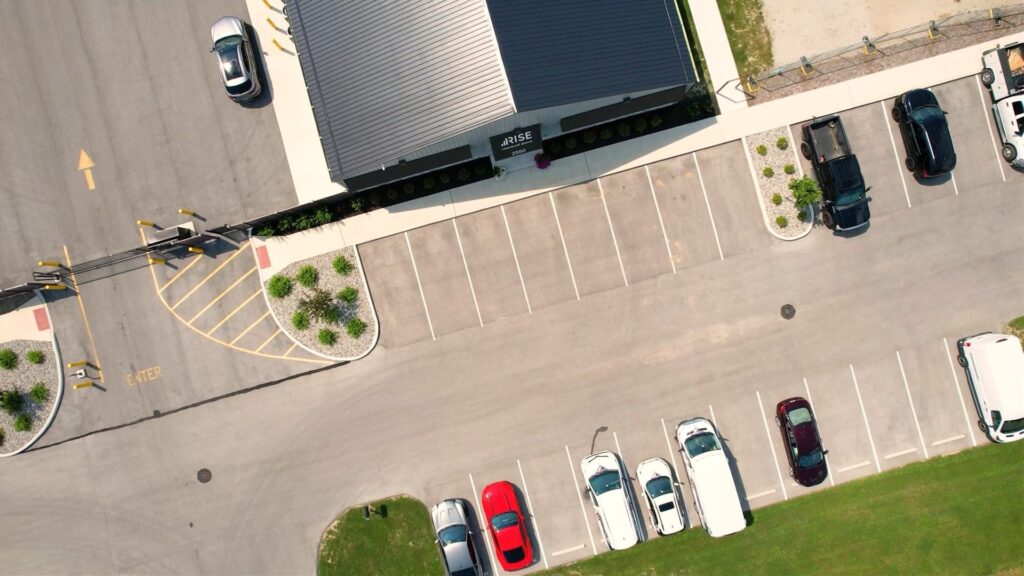With warehouses housing valuable business assets from inventory to data, “Security First” must remain the top priority. Companies rely on warehouse facilities to provide a reliable fortress to safeguard these critical assets using layered safeguards. This requires moving beyond a perimeter fence and camera to implement strategic access policies, compartmentalized storage, and alarm systems.
By renting specialized warehouses designed around robust security, companies can protect their most sensitive goods and information.
Why Prioritizing Security Matters
Protecting assets represents one of the most important responsibilities for any business. Yet traditional office or retail spaces often lack sophisticated security infrastructure to safeguard valuable goods and information fully. Renting dedicated warehouse space specialized for security provides the ideal solution.
Warehouse facilities specifically implement layered defenses like:
- Robust Access Control: Restricts entry to cleared staff through security checks, credentialed access, and strict visitor policies.
- Surveillance Infrastructure: Expansive video camera networks, alarms, and sensors detect abnormalities.
- Secure Design: Reinforced entry points, compartmentalized storage areas, and proprietary building layouts.
- Security Personnel: On-site guards patrol the grounds and respond to issues in real time.
By leveraging rental warehouse spaces designed holistically around asset security first, companies gain peace of mind knowing their most sensitive goods and data remain protected behind the latest safeguards. The specialized infrastructure and policies provide reliable long-term prevention beyond a traditional commercial location. Prioritizing security when selecting rental warehouse space provides a foundational defense for assets that cannot be compromised.
Rentals Deliver Superior Warehouse Security
For many organizations, owning standalone warehouse space proves cost-prohibitive, putting necessary security features out of reach. Renting dedicated warehouse space specialized for improved warehouse security provides the ideal solution through these advantages:
- Financial Flexibility: Tenants save substantially over purchasing to allocate more funding into necessary security staff and systems and technology upgrades.
- Latest Protective Infrastructure: Landlords continuously refresh facilities with the newest singular-owned surveillance cameras, access controls, and alarm systems, passing benefits to renters.
- Distributed Recovery Protection: Unlike singular owned locations, renting allows distributed assets across multiple facilities to mitigate total loss risk from any isolated attack.
- Focus on Core Operations: Let warehouse ownership manage property infrastructure and security enhancements while you concentrate on business processes.
Renting modern warehouse spaces specifically engineered around integrated security systems enables organizations of any size to protect their assets behind strong defenses that were once only accessible to major corporations with massive security budgets. To learn more about warehouse rental vs. buying and the pros and cons, read our guide.
Warehouse Access Control
Restricting access represents the first line of defense for any security plan. Warehouse facilities enable companies to establish stringent access policies limiting entry to only authorized staff through identification checks. This starts by securing the external perimeter with fence lines and gates. Inside, employees gain access to appropriate areas using unique access codes.
Key access control measures include:
- Surveillance Network: Expansive video camera systems monitor each entry point, storage area, and the exterior grounds to detect unauthorized access.
- Access Level Segmentation: Employees only receive credentials for areas essential to their role using least privilege protocols to prevent unnecessary exposure.
- Oversight Authority: A security director manages the access policies, audits the camera footage, oversees external guards, and liaises facility upgrades with the warehouse ownership.
By treating access as a top priority backed by layered physical and digital verification checks, warehousing spaces prevent vulnerabilities that could compromise invaluable inventory and data. Managing strict access protocols represents the core tenant underpinning “Security First” for storage facilities.
The Importance of A Secure Facility Design
While strict access policies provide the first line of defense, the warehouse facility design itself must incorporate built-in protective measures as the next barrier. Modern warehouses integrate reinforced entrances/exits, compartmentalized storage areas, robust alarm systems, and other secure infrastructure.
Integrated Security Design Elements
- Reinforced External Infrastructure: This includes industrial-grade doors/locks, gated perimeter fencing, bollards/barriers, and secured parking areas.
- Alarm & Detection Networks: Advanced alarm systems like door sensors and motion detectors can be added to warehouses to blanket all entry points.
- Compartmentalized Storage Units: Assets are segmented across different rooms, cages, or aisles using partition walls or other barriers granting partial access.
Many modern warehouses integrate climate control systems to regulate temperature and humidity levels, helping better preserve sensitive inventory and equipment vulnerable to shifts in conditions. Read our guide on the benefits of climate-controlled warehouse rentals to learn more.
By partnering with warehouses integrating security into core infrastructure design from the ground up, companies benefit from multiple integrated lines of defense to detect and deter external and internal threats.
Tracking Inventory Through Barcode Scanning
While strong gates and surveillance provide external protections, companies must also implement efficient inventory management protocols crossing over with security to address vulnerabilities from warehouse staff.
To prevent exploited internal access that could lead to data or product theft, incorporate these best practices:
- Cycle Count Auditing: Frequent full or spot checks of warehouse contents compared against historical logs to identify irregularities.
- Barcode Scanning: Comprehensive tagging and then scanning shelf/bin contents during each access interaction to have near real-time visibility into current inventory levels.
- Video Surveillance Audits: Review sample footage of storage areas to ensure protocols are being followed for all put-away/retrieval activity without gaps.
Together, these capabilities enable security directors and warehouse managers to monitor inventory levels closely for early warning signs of shrinkage that may indicate theft or fraud.
Proactive Security with Alarm Networks
Alarm systems represent a core infrastructure component of any warehouse security setup. Facilities can deploy expansive networks of sensors across all entry points and storage areas to detect unauthorized access or abnormal activity.
Different preventative alarms include:
- Door Sensors: Detect forced/prolonged door openings, signaling possible intrusions.
- Motion Detectors: Identify abnormal occupancy outside normal staffing hours.
- Video Analytics: Sophisticated monitoring software automatically flags unusual footage activity for inspection.
Proactive monitoring through these integrated alarm systems prevents intrusions before they ever access inventory or data. Rapid response capability takes care of the rest by neutralizing imminent threats.
Risk Mitigation Through Insurance
Even with extensive security infrastructure, natural disasters, technology failures, or insider threats could still compromise assets. Specialized insurance represents the final failsafe protecting against financial catastrophe should inventory or data still become compromised.
- Theft/Burglary: Rapidly recoup lost inventory value after criminal breaches.
- Fraud: Replace goods compromised by warehouse employee exploitation.
- Natural Disasters: Recover from floods, storms, earthquakes, or fires damaging assets.
- System Failures: For solely digital warehouses, insure against data losses due to technology disruptions.
Insurance cannot substitute for security best practices but serves as the ultimate backup to mitigate uncovered gaps that may emerge over time.
Safe and Secure Warehouse Rentals from RISE Commercial
At RISE Commercial District, we go beyond just storage to provide state-of-the-art secure warehouse rental solutions safeguarding your valuable assets. All our units feature the latest in access controls, surveillance systems, unique access codes, and other protection measures tailored to your inventory and data security needs first.
Our customizable warehouse rental solutions include drive-up access, overhead doors, lighting, and electricity at no extra cost. We offer a range of listings to suit different business needs and sizes. Unlike other commercial properties, we allow short-term commitments as brief as one month.
Amenities include:
- Fully Fenced, Gated, and Video Monitored
- Free Forklift Usage
- Free Electricity and In-Warehouse LED Lighting
- Shipment Receiving Services
- WiFi
- Public Restrooms
- Storage with Electricity
Contact RISE today for a customized quote on a secure warehouse rental matching your asset protection requirements. Read our guide on warehouse rentals for more information.
Frequently Asked Questions
What threats should we protect against?
The core threats center on theft, vandalism, and data breaches from hackers infiltrating connected networks. Insider exploitation also represents a frequent vector needing internal controls.
How can we evaluate a facility’s defenses beforehand?
Tour spaces in person to validate advertised security measures exist as claimed. Check for guards, access control systems, camera coverage, and integrated alarm networks. Request detailed incident reports from owners as well.
Why emphasize inventory management for security reasons?
Frequent scanning identifies irregular shrinkage early before growing into larger loss trends, signaling possible fraud or theft needing investigation. Early detection limits financial downsides.
What security advantages do warehouses offer over traditional retail?
Warehouses allow greater control with restricted access, compartmentalized storage, robust camera systems, and integrated alarms, which are not always feasible in open retail settings.
How can I scale up security as my inventory grows?
Rented warehouses can seamlessly switch units or facilities in the same region to accommodate special projects, seasonal items, or general business growth requiring greater security.



